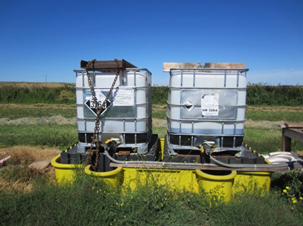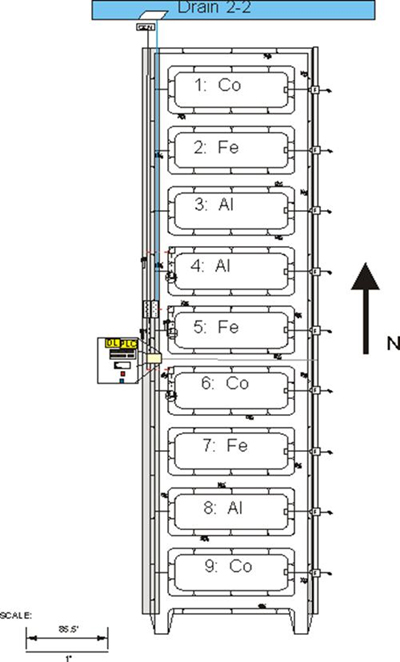Funded through Proposition 13 through California Department of Water Resources



Reports:
Bachand, P.A.M, A.C. Heyvaert, S.E. Prentice and T. Delaney . 2010. Feasibility study and conceptual design for using coagulants to treat runoff in the Tahoe Basin. ASCE Journal of Environmental Engineering. J. Envir. Engrg. 136:1218-1231 doi:10.1061/(ASCE)EE.1943-7870.0000261.
(View)
Bachand, P.A.M., S.M. Bachand, S. Lopus, A. Heyvaert and I. Werner. 2009. Treatment with Chemical Coagulants at Different Dosing Levels Changes Ecotoxicity of Stormwater from the Tahoe Basin, California, USA". Journal of Environmental Science and Health, Part A: Toxic/Hazardous Substances and Environmental 45(2), 137–154.
(View)
Lopus, S. E., P. A. M. Bachand, A. Heyvaert, I. Werner, S. J. Teh, and J. Reuter. 2009. Potential toxicity concerns from chemical coagulation treatment of stormwater in the Tahoe Basin, California, USA. Accepted Journal of Ecotoxicology and Environmental Safety.
(View)
Trejo-Gaytan, J, P. Bachand, J. Darby. 2006. Treatment of Urban Runoff at Lake Tahoe: Low-Intensity Chemical Dosing. Water Environment Research 78(13): 2487-2500
(View)
Bachand, P., A. Heyvaert, J. Reuter, I. Werner, S. Bachand, and S.J. Teh. 2007. Chemical Treatment Methods Pilot (CTMP) System for Treatment of Urban Runoff – Phase I. Feasibility and Design. Final Report for the City of South Lake Tahoe. Submitted to the USFS and the City of South Lake Tahoe. February 22, 2007.
(View)
Bachand, P., J. Trejo-Gaytan, J. Darby and J. Reuter. 2006. Final Report: Small-Scale Studies on Low Intensity Chemical Dosing (LICD) for Treatment of Highway Runoff. Submitted to CALTRANS (California Department of Transportation) by University of California Davis. April 19, 2006.
(View)
Bachand, P.A.M. and A. Heyvaert. 2005. Adsorptive Media Investigations and Testing for Improved Performance of Stormwater Treatment Systems in the Tahoe Basin. Final report submitted to Placer County Department of Public Works and The California Lake Tahoe Conservancy. March 15, 2005.
(View)
Bachand, P.A.M. and Bachand, S. and Heyvaert, A. (2005) BMP treatment technologies, monitoring needs, and knowledge gaps: status of the knowledge and relevance within the Tahoe Basin. ,Sacramento, CA. California State University Sacramento, Office of Water Programs ,(Technical Memorandum ,2007.01 ).
(View)
Bachand, P.A.M., C.J. Richardson and P. Vaithiyanathan. 2000. Phase II Low Intensity Chemical Dosing (LICD): Development of Management Practices. Final report submitted to Florida Department of Environmental Protection in fulfillment of Contract No. WM720. December, 2000.
(View)
This project broadly studies the LICD technology at a site in the Delta. Replicated studies are testing the efficacy of aluminum and iron based coagulants to remove DOC, DBPPs and Hg; subsidence and accretion rates and soil bulk densities in wetland cells with coagulant treatments; net ecosystem effects on vegetation; indirect effects on removal of nitrogen and other water quality constituents; technology required to implement and control this approach; and feasibility, logistics, economics of this technology.
The project is a collaborative effort between Tetra Tech, UC Davis and the USGS. Tetra Tech leads the construction of this technology (i.e. earth work, controls, piping and pumping system, water management); leads collection and analysis of hydrologic and water quality data to assess removal efficiencies for water quality constituents; leads assessment of accretion rates from vegetation establishment and flocculant settling through land surveys; and has developed the final report framework and strategy for producing manuscripts, developing fact sheets and producing implementation and management recommendations. Work has been done in conjunction with laboratory-based and field-based research conducted by the University of California at Davis and the USGS to assess stability of flocculants with regard to sequestration of water quality constituents; fate and transport of Hg; and organic carbon, nutrient and metal dynamics.
Historically, the Sacramento—San Joaquin Delta (Delta) in California was a vast inland freshwater wetland where organic soils over 50 feet deep formed over several millennia. Beginning in the late 1800’s, levees were constructed and pumps were used to drain the area for agricultural use. Draining these lands led to land-surface subsidence of over 20 feet below sea level in some areas, primarily from oxidation of organic rich soils. Currently 98 percent of the Delta is below sea-level (Knowles 2010). Additionally, California’s water network now pushes water through the water that services over 28 million people as a drinking water supply and provides irrigation for nearly 3 million acres of farmland in California’s Central Valley.
Two problems have resulted from these water and agricultural management actions: subsidence has led to a network of levees protecting California’s water supply; and continuous pumping of the organic rich soils in these subsided islands to maintain agriculture results in discharge of dissolved organic carbon (DOC), disinfection byproduct precursors (DBPPs), and Hg into the water system. As land surface elevations decrease, costs for levee maintenance and repair increase, as do the risks of catastrophic levee failure. In addition to immediate loss of life and property associated with levee failure, saltwater intrusion into this freshwater system could result and halt water exports for an extended period of time (Mount and Twiss 2005). Drainage water from Delta peat islands represents a significant source of water quality constituents of concern to drinking water diverted through the Delta (Kraus et al. 2009). When these waters are chlorinated or ozonated for use as drinking water, the presence of DOC leads to the formation of carcinogenic disinfection byproducts (DBPs). Management actions that reduce, or better yet reverse, subsidence in the Delta would reduce these costs and risks.
This low-intensity chemical-dosing (LICD) method addresses both issues. This and related studies shows LICD can remove considerable amounts of DOC, DBPPs and phosphorus, and holds promise for Hg sequestration. Additionally, accumulation of the flocculated material in wetlands, along with sequestration of wetland plant material, is expected to increase land-surface elevations. The project hypothesis is that the combination of coagulation and biotic wetland processes can improve water quality and reverse subsidence beyond that achievable by either technology alone.
Contact
Sujoy Roy
(925) 280-7429





